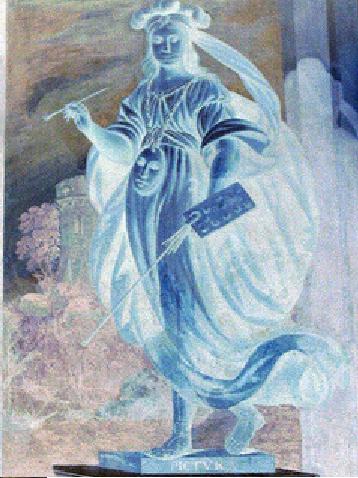BY LETTER
Classical Studies
 Image from Steve Bowers and Anders Sandberg |
Every culture has important formative periods in its past; times when culture in general and the arts in particular reached a perceived apex. Often these achievements set an entirely new direction, and are the standard against which subsequent contributions may be compared for thousands of years thereafter. Often these are the legacies of Renaissance Events, though they can equally well be the result of a long period of prosperity and stability, or of the years immediately after the foundation of a new culture or polity, when patterns are set that will be followed for generations to come. For instance, the "Western"; cultures of Old Earth regarded the preceding Greco-Roman cultures as "classical". Comparable periods for other Old Earth cultures might be Zhou through Han dynasty China for "Eastern"; cultures, or the Vedic Age for the cultures that arose on the Indian subcontinent. A period may be regarded as classical in relation to a particular religion, polity, or art as well. Classical Arabic, from Old Earth's Umayyad and Abbasid times, is still the standard in many parts of the Stellar Umma, and well into the Interplanetary Age key compositions created in Western music between the 4th to 1st centuries BT (16th to 20th centuries c.e.) were referred to as classical. The last period that might be regarded as classical by Terragens in general was the First Federation; since then "classical" has had a much more restricted meaning, applying to some much smaller part of the Terragen sphere, though the local classical period may be a touchstone for many trillions of sophonts. In the Inner Sphere, those who look backward to the height of the Penglai "Empire" or the Eridanus League are good examples; there are many more elsewhere. Classical studies are attempts to understand or emulate these periods. Occasionally this leads to a revival of arts that have long been forgotten, or becomes part of a new synthesis that will itself be regarded as classical by future generations.
Articles
- Classical Age - Text by M. Alan Kazlev
In some usages, a generic term for Old Earth's early to middle Agricultural Age (bronze age and iron age) civilizations. Also used at times for civilizations on Old Earth or in Solsys prior to the Technocalypse. Sometimes this term is used to refer to a civilization's local antecedents, especially in cases where technologies or social complexity have advanced over time. - da Vinci, Leonardo - Text by M. Alan Kazlev
Old Earth Italian Renaissance painter, sculptor, architect, musician, engineer, mathematician, scientist, and inventor, considered the ideal superior, and the supreme example of Renaissance genius. - Early Superior Art - Text by Jay Dugger
Superior art in Solsys from the advent of the first Superiors to the close of the Dark Ages. - Maximalism - Text by Stephen Inniss
An artistic movement, the successor to Modernism, that arose in the middle Information Age and remained widespread through to the dawn of the First Federation. Characterized by the use of complexity and detail. - Patternism, Clade Patternism - Text by Stephen Inniss
The study of the deep seated cultural and aesthetic biases and resulting societal patterns specific to certain clades, and the way these produce and are produced by the physical environment and how they can be manipulated by memetic influence. - Renaissance Event - Text by Stephen Inniss
A flowering of artistic creativity, scientific discovery, technology and trade, together with some significant changes in the operation of personal culture, and a political ferment. There is typically a "rediscovery" of some older cultural models and information or an influx of new foreign ideas, or both, and usually an upsurge in local population. A renaissance event often sets the pattern for future cultural development in ages to follow. - The Prince - Text by Anders Sandberg; minor additions by Stephen Inniss
A work by Niccolo Machiavelli. The original was written on Old Earth circa 464 BT (1505 AD)and published 454 BT (1515 AD). The "Revised Hyperturing edition", published in the Corona Orbital Bands in 9805 AT by a superbright human author with the same name is more widely known in the present day.
Development Notes
Text by Stephen Inniss
Initially published on 07 August 2008.
Initially published on 07 August 2008.
Additional Information






